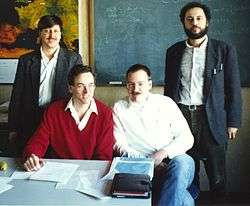EUnet
EUnet was a very loose collaboration of individual European UNIX sites in the 1980s that evolved into the fully commercial entity EUnet International Ltd in 1996. It was sold to Qwest in 1998.
EUnet played a decisive role in the adoption of TCP/IP in Europe beginning in 1988.[1]
History
The roots of EUnet, originally an abbreviation for European UNIX Network, go back to 1982 under the auspices of the EUUG (European UNIX Users Group) (later EurOpen) and the first international UUCP connections.[2][3][4][5]
FNET was the French branch of EUnet.[6]
Once there was a central European backbone node that was separate from the expensive telecom network, TCP/IP was adopted in place of store and forward. This enabled EUnet to connect with NSFNET and CERN’s TCP/IP connections. A connection to the US was also established.[7]
On January 1, 1990 EUnet began selling Internet access to non-academic customers in the Netherlands,[8] making them one of the first companies to sell Internet access to the general public. EUnet provided local service through a respective national EUnet business partner in many European countries.
In 1990 the Soviet IP-based network RELCOM mostly operated by DEMOS powered computers was connected to the EUnet.[9]
In April 1998 the company together with nearly all of the national European business partners of EUnet was sold to Qwest Communications International,[10] which in turn later merged EUnet into the illfated joint-venture KPNQwest.[11] In year 2000 it was estimated that KPNQwest was carrying more than 50% of European IP traffic.[12] Some of the ISPs operating under the name EUnet today can be traced back to the original EUnet, some not.
Most national EUnet affiliates or subsidiaries predated other commercial Internet offerings in the respective countries by many years.
To completely understand the importance and history of EUnet, it is important to realize that until the early 1990s nearly every European country had a telecommunications monopoly with an incumbent national PTT, and that commercial and non-commercial provision of telecommunications services was prohibited or at least took place in a legal "grey zone". During the same period, as part of an industrial political strategy to stop US domination of future network technology, the EC embarked on efforts to promote OSI protocols, founding for example RARE and associated national "research" network operators (DFN, SURFnet, SWITCH to name a few).
Timeline
- 1982 UUCP links established between 4 countries (UK, Netherlands, Denmark and Sweden).[13]
- 1984 kremvax April Fools Joke.[14]
- 1986 FNET, the French branch of EUnet, converted from UUCP to TCP/IP.[6]
- 1988 First connection in Europe to NSFnet by CWI, a Dutch computing centre.[15][16]
- 1990 First offerings for "all comers".[8]
- 1996 EUnet International formed by share swaps with seven of the national organisations.[17]
- 1998 Sale to Qwest for $154.4 mio.[10]
People

The following people were involved in EUnet:
- Teus Hagen[3]
- Daniel Karrenberg[18]
- Piet Beertema[15]
- Peter Collinson
- Keld Simonsen
- Björn Eriksen
- Julf Helsingius
- Glenn Kowack
- Luc De Vos
- Michael Habeler
See also
References
- Fluckiger, Francois (February 2000). "The European Researchers' Network" (PDF). La Recherche (328).
- "Breaking Rules to Break Ground in Global Internet's Earliest Days | Internet Hall of Fame". www.internethalloffame.org. Retrieved 2020-04-03.
- "Teus Hagen | Internet Hall of Fame". internethalloffame.org. Retrieved 2020-02-14.
- http://firstmonday.org/ojs/index.php/fm/article/view/613/534 On the Early Days of Usenet, the roots of the online cooperative culture
- "6th UK Network Operators' Forum Meeting Agenda". www.uknof.org.uk. Retrieved 2020-02-12.
See "15:00 Starting the Commercial Internet in the UK (Peter Houlder)"
- "The path to digital literacy and network culture in France (1980s to 1990s)". The Routledge Companion to Global Internet Histories. Taylor & Francis. 2017. pp. 84–89. ISBN 1317607651.
- "Daniel Karrenberg Helped Bring the Internet to Europe; Now He Keeps It Running | Internet Hall of Fame". www.internethalloffame.org. Retrieved 2020-04-03.
- "Stichting NLnet Jaarverslag 1990". nlnet.nl.
- "Как в СССР появился интернет и почему программисты не боялись цензуры". Rambler. 2016-10-22. Archived from the original on 2016-10-26. Retrieved 2019-12-08.
Первое подключение СССР к интернету произошло 28 августа 1990 года, когда программисты с Овчинниковской набережной обменялись электронными письмами с коллегами из университета Хельсинки. Финляндия была выбрана не случайно: после московской Олимпиады это была единственная страна, с которой сохранилась автоматическая телефонная связь. Вскоре «Релкому» был открыт доступ в общеевропейскую сеть, EUnet. 19 сентября от имени советских пользователей Unix Антонов зарегистрировал домен .su — так появился новый сегмент интернета.
- https://www.wsj.com/articles/SB890869756866767500" Qwest to Buy Internet Provider EUnet of Europe for $154 Million
- https://www.fiberopticsonline.com/doc/kpn-and-qwest-form-700-million-european-fiber-0001 KPN and Qwest Form $700 Million European Fiber Network Team
- KPNQwest hat sein Netz abgeschaltet, heise.de, July 24, 2002.
- http://users.cs.cf.ac.uk/Dave.Marshall/Internet/node16.html Cardiff University/Dave Marshall, History of the internet
- http://godfatherof.nl/kremvax.html The Kremvax Hoax
- "CWI History: details". CWI. Retrieved 2020-02-14.
- "Kees Neggers: Global Networking Requires Global Collaboration | Internet Hall of Fame". www.internethalloffame.org. Retrieved 2020-04-03.
- https://web.archive.org/web/19961104082652/http://www.eu.net/press/press960510eui.html
- "Daniel Karrenberg | Internet Hall of Fame". internethalloffame.org. Retrieved 2020-02-14.
External links
- LucDeVos.com
- Godfatherof.nl, Piet Beertema
- LivingInternet.com, Living Internet Article
- CERN.ch, CERN Internet History